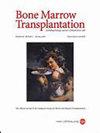造血干细胞移植合并症指数预测单倍体造血干细胞移植后严重再生障碍性贫血患者的临床结果。
IF 4.5
2区 医学
Q1 HEMATOLOGY
引用次数: 0
摘要
为了验证造血细胞移植合并症指数(HCT-CI)预测严重再生障碍性贫血(SAA)患者接受单倍体造血干细胞移植(haploi - hsct)的预后的能力,我们进行了一项包括530名SAA患者的回顾性研究。根据患者的HCT-CI评分将患者分为三种不同的风险类别:低危(HCT-CI评分0,n = 343)、中危(HCT-CI评分1,n = 126)和高危组(HCT-CI评分≥2,n = 61)。低危组100天血小板植入率明显高于中危和高危组(92.1% vs. 86.5% vs. 83.6%, P = 0.014)。此外,与中危组和高危组相比,低危组的5年总生存率(OS, 91.8% vs. 83.3% vs. 70.1%, P本文章由计算机程序翻译,如有差异,请以英文原文为准。

The haematopoietic cell transplantation comorbidity index predicts clinical outcomes for severe aplastic anaemia patients after haploidentical haematopoietic stem cell transplantation
To validate the ability of the haematopoietic cell transplantation comorbidity index (HCT-CI) to predict the outcomes of patients with severe aplastic anaemia (SAA) receiving haploidentical haematopoietic stem cell transplantation (haplo-HSCT), we conducted a retrospective study including 530 SAA patients. Patients were stratified based on their HCT-CI scores into three distinct risk categories: low-risk (HCT-CI scores of 0, n = 343), intermediate-risk (HCT-CI scores of 1, n = 126), and high-risk groups (HCT-CI scores ≥ 2, n = 61). The 100-day platelet engraftment rate was significantly higher in the low-risk group compared to the intermediate-risk and high-risk groups (92.1% vs. 86.5% vs. 83.6%, P = 0.014). In addition, compared with the intermediate-risk and high-risk groups, the low-risk group demonstrated superior 5-year overall survival (OS, 91.8% vs. 83.3% vs. 70.1%, P < 0.001) and graft-versus-host disease-free/graft failure-free survival (GFFS, 80.1% vs. 71.3% vs. 63.6%, P = 0.009). Multivariate analysis revealed that elevated HCT-CI scores and previous antithymocyte globulin treatment were independent risk factors for OS, whereas elevated HCT-CI scores and donor age ≥ 40 years were correlated with worse GFFS. Consequently, the HCT-CI is associated with the clinical outcomes of SAA patients following haplo-HSCT, and it is imperative to closely monitor patients with a high comorbidity burden.
求助全文
通过发布文献求助,成功后即可免费获取论文全文。
去求助
来源期刊

Bone Marrow Transplantation
医学-免疫学
CiteScore
8.40
自引率
8.30%
发文量
337
审稿时长
6 months
期刊介绍:
Bone Marrow Transplantation publishes high quality, peer reviewed original research that addresses all aspects of basic biology and clinical use of haemopoietic stem cell transplantation.
The broad scope of the journal thus encompasses topics such as stem cell biology, e.g., kinetics and cytokine control, transplantation immunology e.g., HLA and matching techniques, translational research, and clinical results of specific transplant protocols. Bone Marrow Transplantation publishes 24 issues a year.
 求助内容:
求助内容: 应助结果提醒方式:
应助结果提醒方式:


